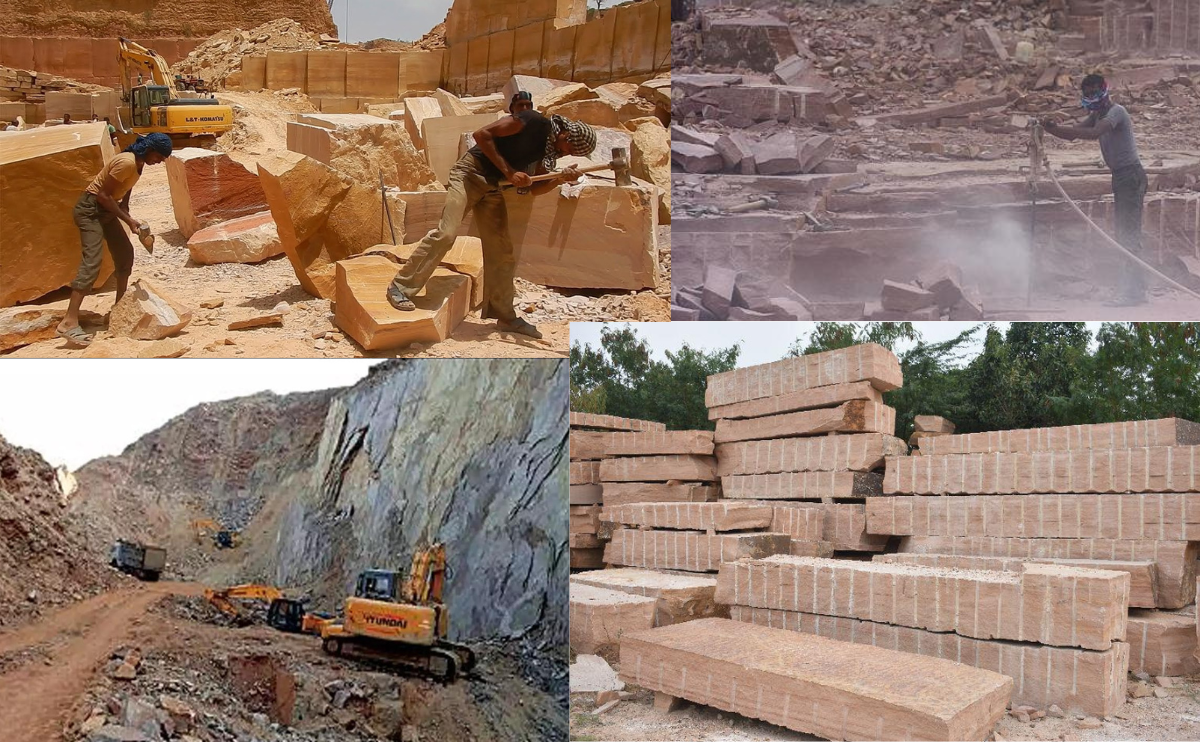When you want your building or house design to be wonderful, you must use Jodhpur Sandstone in your design.
We both are agreeing because we know some solid facts like:
- Jodhpur Sandstone is very famous in the Construction Industry of India.
- Many top Monuments, Cenotaphs, Houses, Schools, Colleges, Universities, Temples, Hospitals, Institutes, Companies and Organizations of India have used it to make their building design a wonderful piece of art.
And I am sure that you must have seen some of these wonderful buildings yourself.
It confirms that using Jodhpur sandstone in your building design is a very wise decision.
But you are probably thinking:
“What is Jodhpur Sandstone?”, “How is it different from other sandstones?” etc. etc.
That’s what this article is about.
I am going to answer exactly all these questions in this article…
…And where you can order these Sandstones for your beautiful house or building design.
So, let’s start with Sandstone:
About Sandstone
Definition:
Sandstone may be defined as a sedimentary stone made up of tiny grains of quartz and other minerals of fairly uniform size and often smooth and rounded.
These grains are held together by a cementing material which may be siliceous or ferruginous. The toughness of sandstone depends mostly on the nature of this cementing material.
Where is it found?
Mostly sandstone is formed in oceans, lakes and rivers where tiny bits of rock and dirt settle to the bottom.
Year after year, these layers of sand get buried under tons of more sand and dirt until it is turned into solid rock.
Characteristics:
Sandstone is an extremely hard and tough material and consists of consolidated masses of sand deposited by moving water or wind.
Some of the sandstones are so homogeneous and soft that they are capable of receiving most elaborate carving and filigree work.
Color:
Sandstone can be found in many colors across different places. The color of the rock is largely determined by the cementing material:
- Iron oxides produces red or reddish-brown sandstone
- And the other materials produce sandstone in white, grayish or yellowish sandstone.
About Jodhpur Sandstone
Jodhpur sandstone is also termed as “chittar patthar”.
It is mostly used in monuments, beautiful buildings and houses.
Natural Jodhpur Sandstone is believed to be the youngest of the quartz-based stones as each stone has a different level of porosity, hardness and compressive strength.
Its texture is noteworthy and the medium sized grains are all of the same size.
The color of sandstone is variable and depends upon the composition of the binding material and therefore it varies from Red, Brown, Pink, Greenish, Yellow, Gray and White.
It is superior to other sandstones from other parts of India as well as the globe in many ways.
Some of its superior qualities are:
- Inherent aesthetic appeal
- Attractive appearance
- Least affected by air, sunshine, rain and extreme weather conditions.
- Do not require surface treatment due to high silica content
- Works almost like granite when used in cladding.
- Resistant to acid, alkali, salinity and thermal variance
For thousands of years Sandstone has been quarried from Jodhpur and used in construction.
It can be seen in the form of the archeological monuments and the cenotaphs built all around Jodhpur.
Large scale quarrying was done in the 14th century to build the most magnificent fort of India, the Mehrangarh Fort.
Due to its superior qualities it is exported to Canada, Japan and Middle East countries.
Uses of Jodhpur Sandstone
Jodhpur Sandstone is suitable for both domestic and commercial use.
It is highly admired for its natural beauty and architectural properties, which makes it useful for interior as well as exterior decoration.
This can be chiseled and dressed to a smooth surface in various attractive shapes.
Jodhpur Sandstone is used:
- In production of Plate Glass, fine Table Glassware and common Glassware.
- In Fireplaces, Walls, and Walkways.
- As Decorative Stones.
- As Bookends, Clocks, Paperweights, Coasters, etc.
- In load bearing Masonry.
- In cladding as Sandstone Slabs and Tiles.
- In chemical industries as Flooring, Wall Fixing and Lining due to its acid and alkali resistant properties.
- As Pillars, Arches, Garden Furniture, Fountains, Landscaping Products, Stone Arts & Crafts due to its ideal carving and architectural properties.
- In Roofing, Flooring, Paving, Paneling, Beams, Arches, Doors and Window Sills, Wall Facing, Fence Posts, MileStones etc.
- For exterior Cladding in Seashore Buildings due to acid & thermal resistant properties.
- For carving Windows and Jallis.
- For multi storied Buildings, Swimming Pools, Religious places of worship and applications in extreme climate due to its high strength and other properties.
Sandstone Care
Although Sandstones are rough and tough, they still require care to ensure that they last for even more years for generations and impart natural beauty to the building.
Few tips to proper care are:
- Keep stone dust-free. Always use a neutral cleaner (not acidic or basic). If you are using a vacuum cleaner, then ensure that metal or the plastic attachments or the wheels should not scratch the surface.
- Do not drop down heavy weight with impact on Sandstone as these produce breakage in it.
- Do not place hot pans directly on it, instead use support or carpets under them.
The various handcrafted items
Sandstone is used to create a large combination of artifacts which are as follows:
- Bird Bath: It is an ornamental basin often placed in gardens for birds to bathe. It is made of pure sandstone and is available in various designs, shapes and sizes to suit your requirements.
- Flower Vases: It is an open container used for keeping flowers. These vases are creatively made up of sandstone that imparts a cultural touch on them.
- Garden Ornaments: Sandstone is used in making Garden Ornaments like Fountains, Garden Furnitures, Stone Planters, Statues, Garden Lamps, Garden Troughs, Pedestals, Garden Pillars, Garden Miniatures. These unique garden accessories change the look and the feel of the garden completely and captures the attention of the viewers.
- Indoor Wall Fountains: These are perfect as an interior item. The best part is that they do not occupy much space and impart uniqueness besides the calm composure and add mildness. These types of sandstone fountains are placed in the living room or in the corridor or can even be put next to the staircase. These fountains are custom designed to suit the particular requirement. The fountain range is mostly available in Jodhpur Pink, Red, Brown, White; Jaisalmer Yellow.
- Figurative Sculptures: These are the huge statues that are beautifully carved from sandstone. The sculptures are crafted out with the inspiration from old age, traditional art and even from modern art.
- Sandstone Candle Stands: Sandstone candle stands are available in a range of designs and shapes. It is not only used to hold candles but also as a showpiece that enhances the interior decoration.
- Besides the above listed items there are many more products that are crafted out of sandstone like outdoor fountains, religious statues, table bases, photo frames, paper weights, coasters and many more.
Technical Information of Jodhpur Sandstone
1. Physical Properties of Sandstone
Color
The color varies from red, pink, brown and white. The variation is the result of the binding material and its percentage constituent.
Water Absorption
The capacity of water absorption is 1.25%.
Density
It is 2.42 Kg/m3.
Compressive Strength
It is 390 Kg/cm3.
Modulus of Rupture
It is 220 Kg/cm3.
2. Chemical Properties
Material Composition
SiO2 96.60
Fe2O3 1.20
Al2O3 1.00
CaO 0.28
MgO 0.20
L.O.I. 0.50


